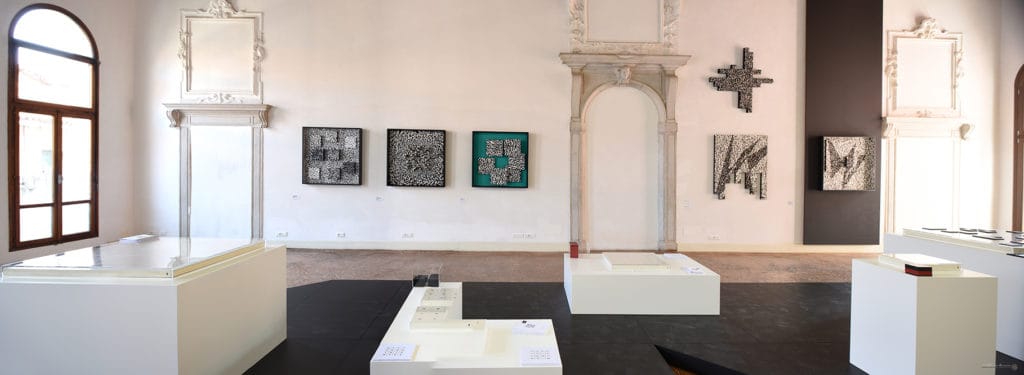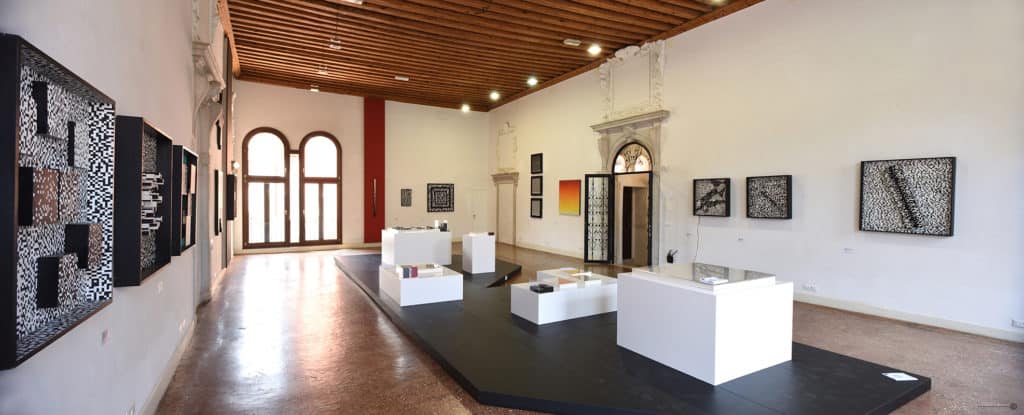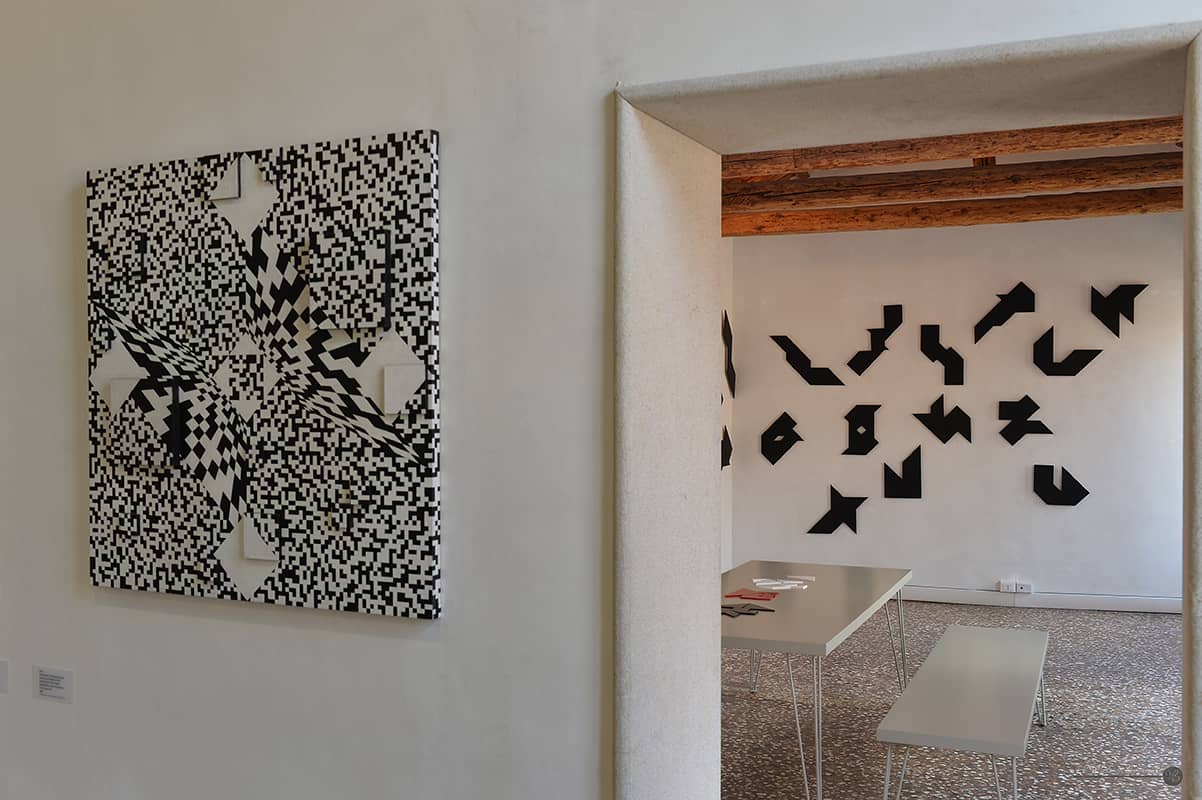Various editions of biennales, art fairs and festivals abound in 2017. We have documenta 14 in Athens and Kassel, as well as Sculptur Projekte in Munich to visit. Many of you will probably head to the Venice Biennale and take a break from exploring the national pavilions in order to see Damien Hirst’s monumental solo show at the Palazzo Grassi and Punta Della Dogana, or Philip Guston’s paintings at the Gallerie dell’Accademia. Nevertheless, the exhibition of Ryszard Winiarski’s paintings, the Collateral Event of the Venice Biennale at the Palazzo Bollani, takes center stage overpowering the Polish pavilion when it comes to the scale, message, viewer participation and prominence of the artist, whose works are put on display. Rarely is a solo show by a late artist included in the official biennale selection. Rarely do we, the Contemporary Lynx team, bother to mention the practice of a deceased seminal artist. Therefore, the exhibition in Venice provides us with a perfect opportunity for introducing you to Ryszard Winiarski, one of the greatest yet forgotten twenty-century artists and his internationally renowned art.

Ryszard Winiarski: Event-Information-Image, Venice 2017, photo by Wladimiro Speranzoni
Several years ago, I used to work at a private contemporary art gallery where we organised a summer show of selected pieces in its collection. Confronted with paintings by Ryszard Winiarski, the viewers from abroad always enquired whether they were looking at the example of digital art by some young emerging artist fascinated with QR codes. And I would always explain that conceptual paintings were done way back, in the 1970s, when no one had even heard of QR codes. Looking back, the associations surely seem more unavoidable and less far-fetched considering these paintings’ visual representation, form, inclusive nature of the creative process, coding games and infinite solutions offered to mathematical and statistical problems. All jokes aside, Winiarski could be deemed the coding visionary…of sorts.
Anna Muszyńska, the exhibition’s curator, guides us through different stages in the evolution of Winiarski’s thought and form, while steering clear of formulating the theoretical premise underlying the exposition with a mathematical precision and prowess, which would be hailed by the artist himself. The show resonates with the viewer on three intersecting and equally important planes, namely the intellectual, aesthetic and inclusive ones.
Theory, logic and attempts at objectivism
In his graduate art project entitled “Event-Information-Image” (1966), Winiarski had already demonstrated his fresh and mature perspective on art, which would shape and evolve for years to come – apart from one of his pieces from the same period, the Venice exhibition includes works from the collections of the Muzeum Sztuki in Łódź, Anna and Jerzy Starak Foundation (chief patrons), as well as other public and private entities. One could easily gather from the works’ titles that the artist strived to transfer notions from the fields of mathematics, statistics and logic to the visual arts. Despite using a canvas, Winiarski opted for the terms area, statistical field, set and event. “Prior to the production of an object or a painting (or should I say ‘areas’ since the word painting falls short of encapsulating their true nature), I always establish the rules of the process, the rules of the game, if you wish. Only then, do I rely on chance represented by the coin toss, dice roll, roulette, random table number or pre-programmed computer. A strict game is played in the two- or three-dimensional space according to the logic of chance. The programmes multiply, random variables shift, the rules of the game become more and more confounded and the outcome does, too”, said the artist himself. The titles weren’t the only components that were supposed to bridge the divide between art and science. Initially, Winiarski wanted to discover the objective and unquestionable beauty. As a result, he decided to erase the human and personal intervention from the compositions and delve into scientific facts and rules instead. In order to design a purely unambiguous code, he distilled his colour palette to black and white only reminiscent of the binary system of zeros and ones. Furthermore, the square canvas highlighted the transparency due to the lack of doubts it raised regarding its direction and surrounding space as opposed to, for instance, a circle. His message was precise, succinct and direct. In the following years, Winiarski explored the infinite creative possibilities offered by science even further. The schemes acquired a larger degree of complexity by means of his exploration of statistical models determined by a continuous uniform distribution, penetration of a real and illusionary space in the third dimension and sets of objects. The method, however, worn him out. Hence, he deferred to chance.
Winiarski pored over the notions of a variable, function and model. The system resulted in the new form of an object that embodied arbitrariness, variable, infinity of time and space. Consequently, Winiarski branched out into creating three-dimensional installations, reliefs, kinetic objects, game scenarios and enormous public art projects.
Representation and emotions
At the beginning of his career, Winiarski openly disapproved of an intuitive and aesthetic interpretation of his works. Special diagrams spelling out the rules of the game used to hang right next to his pieces in order to defy subjective perceptions of an image and demonstrate that underlying principles of art creation can be objective and scientifically proven. As time passed, his approach has gradually changed. Turning point came in the early 1970s when Winiarski acknowledged that creative process is in fact subject to emotions and chance. “I put chance on such a high pedestal, because I wanted to respect the rules of life,” Winiarski were to write many years later.
In the 1985 interview he gave, the artist claimed, what follows: “For years, I’ve outright rejected an emotional approach to my art (…) emotions were completely out of the question. However, everything has changed lately. Emotions were emancipated. The game of channeling your own feelings and expression while creating art has already begun.” His view manifests itself in the design of the exhibition at hand, held in the small architectural gem that brings out the very essence of Winiarski’s works and provides a neutral and somehow dramatic background for their most visually appealing elements, such as a black and white colour scheme, geometry and a blatant detachment from their surroundings. The op-art aesthetics and dearth of natural elements’ depiction tantalise the viewer who is drawn into the austere scientific system based not only on statistical, mathematical and logical problems or some visual sensory experience…

Ryszard Winiarski: Event-Information-Image, Venice 2017, photo by Wladimiro Speranzoni
Viewer engagement
The exhibition in Venice stresses the importance of viewers’ contribution to an act of creation. In Winiarski’s opinion, the mere completion of an object had never been an end in itself, which is also evident from the abovementioned role of a title and a viewer-object relation. What truly mattered was an entire mechanism, stages in the process that lead to the creation of this precise object. Consequently, Winiarski designed “Games”, which engaged the audience in the creative process. Upon entering the very first room of the gallery, contestants are immersed in a set of games of chance displayed in the middle. Organoleptic analysis allows them not only to gain a deeper understanding of the project’s fundamental rules and principles, but also appreciate the role chance plays in the process of art creation. On the one hand, Winiarski’s reliance on viewer participation called into question the status of an omnipotent artist-creator. On the other hand, game participants had to follow a set of rules imposed on them by that artist. These rules, however, are far from universal. Instead, they govern our own way of thinking, and guide us through Winiarski’s solo show. Unwittingly, we absorb the theory, which now seems much more accessible. Scientific parlance is transformed into the universal language spoken by every single Biennale visitor, their country of origin and culture notwithstanding.
Back in the 1970s, Winiarski established a strong intellectual and creative connection with the artists and critics in the Netherlands. As an exceptionally active member of the community, he shared his views and ideas with those who also advocated an interdependence of art and science. The sense of unity of artists passionate about their common outlook on art encouraged vigorous debates, exhibitions, journeys and conferences, e.g. the 1974 symposium in Gorinchem, where Ryszard Winiarski executed two projects in the town’s public space under the common title “Geometry in a Landscape”. In 1976, he hosted “Game Parlour”, i.e. the iconic solo show at the Kunstcentrum Badhuis in Gorinchem run by Antionette de Stigter at that time. In the years to follow, he was a guest lecturer at a number of universities abroad, such as the Offenbach University of Art and Design (1983). “One Painting and Many Dedications” exhibition is widely considered the culmination and embodiment of Winiarski’s close ties with other artists. The exhibition presented one work by Ryszard Winarski and 52 paintings dedicated and given to him over the years by his artist friends, among others: Christo&Jeanne-Claude, Sol Le Witt, Dora Maurer, Jacob and Max Bill, Shizuko Yoshikawa, Georg Karl Pfahler, Jan Eric Visser, Zbigniew Gostomski, Tomasz Ciecierski and Tomasz Tatarczyk.

Ryszard Winiarski: Event-Information-Image, Venice 2017, photo by Wladimiro Speranzoni
The artist died in 2006. The exchange of ideas may continue, nevertheless. To showcase someone’s work and to save it from oblivion is a noble gesture, which matters a great deal. The exhibition in Venice restores the art practice of Ryszard Wieniawski to its former glory and fills a yawning gap in our knowledge regarding geometric abstraction.
Collateral Event of the 57th International Art Exhibition
La Biennale di Venezia
13th May – 26th November 2017
Palazzo Bollani Castello 3647, Venice
Promotor: Starak Family Foundation, Spectra Art Space
Founders: Anna and Jerzy Starak
President of the Foundation Board: Elżbieta Dzikowska
Curator: Ania Muszyńska









